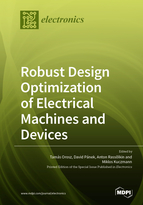Robust Design Optimization of Electrical Machines and Devices
A special issue of Electronics (ISSN 2079-9292). This special issue belongs to the section "Systems & Control Engineering".
Deadline for manuscript submissions: closed (27 March 2022) | Viewed by 33732
Special Issue Editors
Interests: optimization; robust design optimization; modeling; numerical analysis; electrical machines; transformers; applied and computational mathematics
Special Issues, Collections and Topics in MDPI journals
Interests: optimization; robust design optimization; modeling; numerical analysis; electrical machines; applied and computational mathematics
Special Issues, Collections and Topics in MDPI journals
Interests: electrical drives; mechatronics; electric vehicles; electrical machines
Special Issues, Collections and Topics in MDPI journals
Interests: control system synthesis; computer-aided instruction; electrical machines; finite element analysis; magnetic hysteresis; nonlinear control systems; state–space methods
Special Issues, Collections and Topics in MDPI journals
Special Issue Information
Dear Colleagues,
Optimization is an essential part of research and design for any mechatronic device, especially electrical machines. Finding the optimal solutions may lead to cheaper, more economical products, faster and more efficient production, or more sustainable solutions. However, optimizing such a complex system as an electrical machine is a computationally expensive optimization problem, where many physical domains should be considered together. However, a good, practical design needs to consider the electrical device’s design parameters; nevertheless, it should be insensitive to parameter changes or manufacturing tolerances. This Special Issue focuses on papers which show how modern artificial intelligence tools can be used for robust design optimization of electric machines and electrical devices, or how these tools can be benchmarked, or the correctness of the result validated.
Topics of interest for this Special Issue include but are not limited to:
- System-level modeling, multidomain automatic analysis tools, co-simulations, etc.;
- New numerical and analytical modeling techniques;
- Advanced modeling (electromagnetic, thermal, NVH, mechanical, EMC, insulation, etc.);
- Advanced models for diagnosis;
- Electromagnetic materials, iron losses, additional losses;
- Optimization techniques;
- Advanced testing (multiphysics performances, standard tests, life accelerated testing, etc.);
- Optimization and learning under uncertainty
- Model-based software development and validation of optimization of electrical machines or electric devices;
- Surrogate and reduced-order modeling of electric machines and electric devices.
Dr. Tamás Orosz
Dr. David Pánek
Prof. Dr. Anton Rassõlkin
Prof. Dr. Miklos Kuczmann
Guest Editors
Manuscript Submission Information
Manuscripts should be submitted online at www.mdpi.com by registering and logging in to this website. Once you are registered, click here to go to the submission form. Manuscripts can be submitted until the deadline. All submissions that pass pre-check are peer-reviewed. Accepted papers will be published continuously in the journal (as soon as accepted) and will be listed together on the special issue website. Research articles, review articles as well as short communications are invited. For planned papers, a title and short abstract (about 100 words) can be sent to the Editorial Office for announcement on this website.
Submitted manuscripts should not have been published previously, nor be under consideration for publication elsewhere (except conference proceedings papers). All manuscripts are thoroughly refereed through a single-blind peer-review process. A guide for authors and other relevant information for submission of manuscripts is available on the Instructions for Authors page. Electronics is an international peer-reviewed open access semimonthly journal published by MDPI.
Please visit the Instructions for Authors page before submitting a manuscript. The Article Processing Charge (APC) for publication in this open access journal is 2400 CHF (Swiss Francs). Submitted papers should be well formatted and use good English. Authors may use MDPI's English editing service prior to publication or during author revisions.








